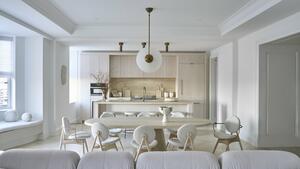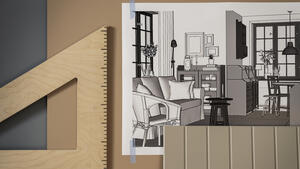For years, e-design was viewed as the déclassé cousin of its “real” in-person counterpart. The pandemic turned every designer into an e-designer—at least briefly—and brought such services fully into the fold. Now, whether it’s through platforms like The Expert or simply using Zoom to supervise a drapery installation, just about every designer offers some version of design online. Only fitting, then, that the reverse has also happened: Denver-based e-design platform Havenly is expanding into in-person services. The program will start in Atlanta, Austin, Chicago, Dallas, Denver, Houston and New York, and will expand to an additional 20 to 30 cities nationwide in the next year.
“This has been something our customers have requested for years,” says Veronica Collins, Havenly’s chief revenue officer. “[But] a lot of macro-trends were drivers for this: We saw a huge focus on interior design through 2020 and 2021. People that had not explored it before were looking into both virtual and in-person services as well.” The offering starts at an introductory rate of $499 for the first room (over time, Havenly will increase that price to $699) and $199 for each additional room.
The service itself is less a traditional interior design experience, but more an enhanced version of Havenly’s existing offering. At the outset of a project, a Havenly designer will visit the client’s home to discuss the space and take measurements. The next step happens online, with the Havenly designer using the platform’s tools to make product selections and a rendering, and the client purchasing the items through the company’s portal. Upon delivery of the order, the designer will make a second and final in-person visit to help with styling.
By offering in-person services for the first time, Havenly is targeting a demographic that wants a personalized experience but isn’t quite ready for an all-out design process. “We saw customers we had acquired six to eight years years ago buying larger homes and coming into larger income and having a different need for design that was in person but [who] weren’t at the AD100 budget level yet,” says Collins.
For the platform itself, Collins says, the economics are appealing. In early testing of the program, average order values from in-person projects were anywhere from five to 10 times higher than Havenly’s standard e-design projects. The in-person option also opens up the platform to a wider range of projects. Most of the work on its virtual platform is for one to three rooms. In-person projects can increase that number to six to eight rooms, meaning the platform will likely be designing more complete homes.
In early testing for the program, Havenly also identified a unique hybrid customer. When the company advertised its new service, it found that some clients clicked on an ad for in-person design but ended up choosing a virtual package. Others mixed and matched. “Some customers want in-person services for their living room or dining room—core spaces—but potentially want virtual services for their nursery or bedroom,” says Collins.
To execute this initiative, Havenly is drawing on its existing talent pool of freelance designers and looking to hire 40 to 50 more. Collins says designers will be paid on a per-job basis and earn a commission on sales placed through the platform.
This move may understandably be viewed with some wariness by traditional designers concerned that the comparatively low price point will drag down the market for a full-service experience. But viewed in the broader context of the e-design industry, it fits a pattern. The pandemic’s refocusing of consumer consciousness on home and its normalization of remote everything has led to a swell of opportunities in e-design. At the same time, millennials are entering their home-buying years, and the opportunity to offer a version of design that connects with their preferences in both style and convenience is a lucrative one. As such, e-design providers are rushing to meet the market in new ways—see the rise of The Expert, or Modsy’s recent move into a renovation service.
Any IRL service, however clearly defined, has more room for unpredictability than a purely digital experience, and the messiness of providing design at scale has played a role in the downfall of at least one other player in the space. But Havenly’s move is extremely measured—by adding an in-person component to a process it has already fine-tuned over the years, it’s venturing into new territory with a map and a compass.
“We know the areas that we’re good at. We’re good at delivering great designs in our technology for our customers with a person-focused approach,” says Collins. “In-person still lends to that core capability. We have not gone beyond that. All we’ve done is enhanced that with interactions with the customer.”
And despite whatever risks the new initiative may pose, for Havenly, it’s worth it. “[Now] Havenly is not in person or virtual; what we’re selling is a national brand in interior design services that’s affordable and accessible,” says Collins. “That is made fully possible by the addition. That’s where there’s a lot of growth and excitement and potential.”
Homepage image: Courtesy of Havenly




























